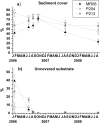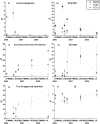Role of Recruitment Processes in Structuring Coralligenous Benthic Assemblages in the Northern Adriatic Continental Shelf
- PMID: 27701418
- PMCID: PMC5049771
- DOI: 10.1371/journal.pone.0163494
Role of Recruitment Processes in Structuring Coralligenous Benthic Assemblages in the Northern Adriatic Continental Shelf
Abstract
Coralligenous biogenic reefs are among the most diverse marine habitats in the Mediterranean Sea. The northern Adriatic mesophotic coralligenous outcrops host very rich and diverse epibenthic assemblages. Several studies quantified the low temporal variability and high spatial heterogeneity of these habitats, while processes driving structuring and differentiation are still poorly understood. To shed light on these processes, temporal and spatial patterns of colonisation were investigated using travertine tiles deployed on three coralligenous outcrops, corresponding to the main typologies of benthic assemblages described in previous studies. Three years after deployment, assemblages colonising travertine tiles resembled the differentiation among sites revealed by the natural assemblages in terms of major ecological groups. Processes structuring and maintaining species diversity have been explored. Pioneer species with high reproduction rate, long distance larval dispersal and fast growth (e.g. the serpulid polychaete Spirobranchus triqueter and the bivalve Anomia ephippium), were the most abundant in the early stages of recruitment on the two outcrops further away from the coast and with lower sedimentation. Their success may vary according to larval availability and environmental conditions (e.g., sedimentation rates). At these sites early-stage lasted 10-12 months, during which even species from natural substrates began colonising tiles by settlement of planktonic propagules (e.g., encrusting calcareous Rhodophyta) and lateral encroachment (e.g., sponges and ascidians). On coastal outcrop, exposed to a higher sedimentation rates, tiles were colonised by fast-growing algal turfs. Resilience of northern Adriatic coralligenous assemblages, and maintenance of their diversity, appeared largely entrusted to asexual reproduction. Exploring the mechanisms that underlie the formation and maintenance of the species diversity is crucial to improve our understanding of ecological processes and to implement appropriate conservation strategies of the Adriatic coralligenous reefs.
Conflict of interest statement
The authors have declared that no competing interests exist.
Figures








Similar articles
-
The two facets of species sensitivity: Stress and disturbance on coralligenous assemblages in space and time.Mar Pollut Bull. 2017 Apr 15;117(1-2):229-238. doi: 10.1016/j.marpolbul.2017.01.072. Epub 2017 Feb 6. Mar Pollut Bull. 2017. PMID: 28185652
-
Hydroids (Cnidaria, Hydrozoa) from Mauritanian Coral Mounds.Zootaxa. 2020 Nov 16;4878(3):zootaxa.4878.3.2. doi: 10.11646/zootaxa.4878.3.2. Zootaxa. 2020. PMID: 33311142
-
Ecological shifts in Mediterranean coralligenous assemblages related to gorgonian forest loss.PLoS One. 2014 Jul 23;9(7):e102782. doi: 10.1371/journal.pone.0102782. eCollection 2014. PLoS One. 2014. PMID: 25054286 Free PMC article.
-
Chasing genetic structure in coralligenous reef invertebrates: patterns, criticalities and conservation issues.Sci Rep. 2018 Apr 11;8(1):5844. doi: 10.1038/s41598-018-24247-9. Sci Rep. 2018. PMID: 29643422 Free PMC article. Review.
-
Threats to macroalgal coralligenous assemblages in the Mediterranean Sea.Mar Pollut Bull. 2012 Dec;64(12):2623-9. doi: 10.1016/j.marpolbul.2012.07.027. Epub 2012 Aug 3. Mar Pollut Bull. 2012. PMID: 22863350 Review.
References
-
- Ballesteros E (2006) Mediterranean coralligenous assemblages: a synthesis of present knowledge. Oceanogr Mar Biol, Annu Rev 44: 123–195. 10.1201/9781420006391.ch4 - DOI
-
- Cocito S, Bedulli D, Sgorbini S (2002) Distribution patterns of the sublittoral epibenthic assemblages on a rocky shoal in the Ligurian Sea (NW Mediterranean). Sci Mar 66: 175–181. 10.3989/scimar.2002.66n2175 - DOI
-
- Calcinai B, Bertolino M, Bavestrello G, Montori S, Mori M, Pica D, et al. (2015) Comparison between the sponge fauna living outside and inside the coralligenous bioconstruction: A quantitative approach. Mediterr Mar Sci 16: 413–418. 10.12681/mms.900 - DOI
-
- European Commission—DG Environment (2013) Interpretation manual of European Union habitats—EUR28. 144 p.
-
- UNEP-MAP-RAC/SPA, editor (2008) Action plan for the conservation of the coralligenous and other calcareous bio-concretions in the Mediterranean Sea. Tunis: RAC/SPA; 21 p.
MeSH terms
LinkOut - more resources
Full Text Sources
Other Literature Sources

